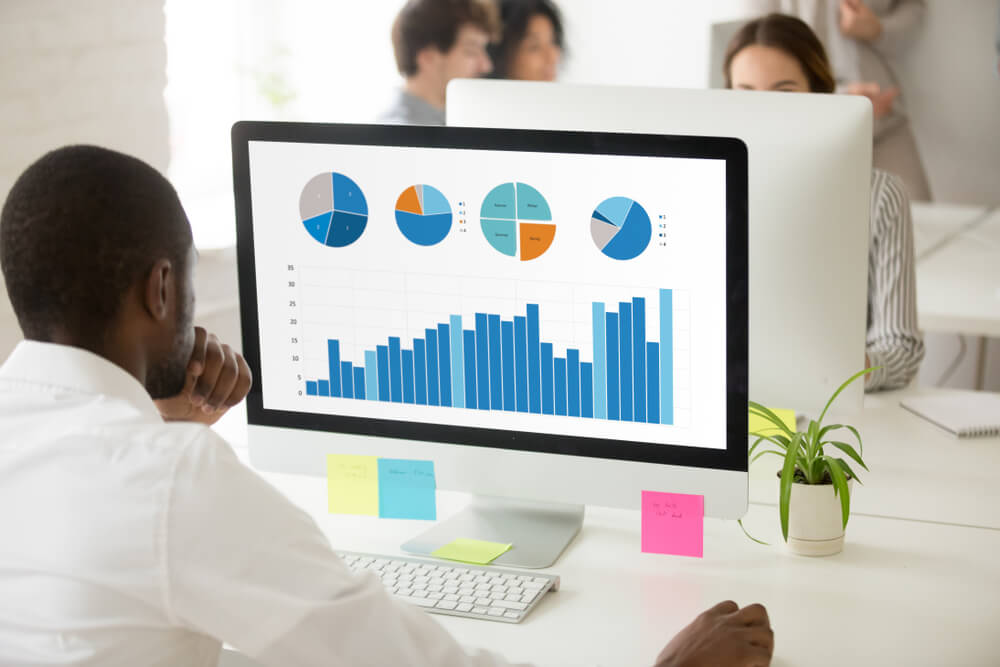
How to monitor staff productivity – the ultimate guide
As a business owner or manager, monitoring workplace productivity is part of your role. But in the rapidly changing modern business landscape, what’s the best way to do it? There are a lot of ways to monitor employee productivity, and it doesn’t always require micromanagement.
The importance of monitoring productivity
It might sound silly to ask why productivity is important. Every business wants to be more productive and achieve better results. Some businesses need to cut expenses and achieve greater results with fewer resources. So, addressing issues of poor productivity is all part of that. However, monitoring productivity has many more benefits than that.
When performance and productivity become part of the culture, a workplace can thrive. Everybody has clear expectations, performance is monitored, and issues are addressed quickly. That’s the ideal workplace in theory – you just need to find ways to make it a reality.
Employee morale and engagement
Monitoring productivity has a profound effect on employee engagement. If you do it poorly, it can reduce staff morale, increase staff turnover and create an unpleasant work environment. When it’s done well, employees see that everybody is held to the same standards and those who don’t perform are managed accordingly. It means everyone is more involved in the running of the business, and aware of how their productivity affects the rest of the team.
Potential for career development
If you’re keeping an eye on employee activity and how employees are meeting and exceeding expectations, you’re in a good position to identify those staff members who are in the position for a promotion, or who may be a good candidate for future leader positions as they open up.
Monitoring staff performance is beneficial in encouraging a workplace with room for growth and career development. If you frame productivity monitoring to your team in this way, your employees can see how monitoring benefits them and their career growth, rather than just seeing it with negative ‘Big Brother’ connotations.
Play to employee’s strengths
Keeping your finger on the pulse of employee performance will allow you to identify those employees who are going above and beyond, and also allow you to identify employee strengths. This way you can allocate tasks effectively, ensuring specific tasks are given to the employees who are most productive in that particular area.
Safe work environment
Employee monitoring can help ensure the workplace is a safe one. When employees know they are being monitored, they are more likely to take that little bit of extra care with their work, which can reduce mistakes. In addition, mistakes can be picked up early to avoid accidents or issues developing.
Opportunity for business growth
Productivity monitoring will allow team leaders to have a real look into the efficiency of processes within the business. In this way, productivity monitoring can identify areas and processes which can be improved upon, ultimately allowing for increased efficiency across the board.

Monitoring productivity for remote teams
It’s worth mentioning that remote workers, virtual teams and hybrid workplaces present a different challenge when it comes to employee productivity monitoring. In a normal office, even without looking over people’s shoulders, you can get an idea of whether people are at their desks or not. These traditional signs of productivity aren’t as easy to spot when people are working remotely.
The suggestions listed below for how to monitor staff productivity can be adapted to work equally as well in a virtual environment, so you can ensure that all staff are managed the same way, regardless of their location.
How to monitor staff productivity
There are a lot of ways you can measure productivity in the workplace, but probably the most obvious one is to look at results. Many employers get bogged down looking at hours worked, how many coffee breaks someone has had or whether people have taken an afternoon off. The reality is, if you have clear expectations for what people should be able to achieve in the time you pay them for, does it matter if they take an extra coffee break?
Ultimately, results are the main guiding factor behind measuring productivity, but there are still plenty of ways to ensure you’re managing employee performance properly.
Understand what you’re monitoring
The very first thing you need to do when monitoring productivity is to define productivity in your workplace. Are you focused on business outcomes? Sales? Do people have certain projects or tasks to complete within a deadline? Every workplace values different achievements, and within each workplace, there may be teams or staff members who have different expectations according to their roles.
There has been a big switch in recent times for businesses to focus more on outcomes when examining productivity metrics, rather than just hours worked. Rather than worrying about how long something takes, companies are rewarding quality of work over speed. Of course, there are limits to this and most tasks still have a deadline to be met. It can be a balancing act, but the key point is to work out what productivity means in your workplace.
Provide clear expectations
Once you’ve established what productivity means to you, it’s time to communicate these expectations clearly with your staff. Monitoring performance and productivity is useless if people don’t know what they’re supposed to be achieving to begin with.
Set clear expectations for your staff, preferably in written form so that there is always a record and your team can refer back to it as needed. You might choose to set blanket expectations for all staff, but if you have different teams and jobs to manage, this can be problematic.
Setting clear expectations for your team and aligning their personal performance to career advancement or other opportunities is a great way to show how high productivity levels can benefit everyone.
Use project management software
The great thing about project management software is that it removes some of the need for micromanaging. Most people don’t enjoy being micromanaged, preferring some autonomy over how they get their work done. However, someone needs to be responsible for performance and deadlines, and that’s where project management software can help.
With clear and easy systems in place, task management becomes simple. You can also set deadlines, create calendar reminders, collaborate on projects and do much more. Best of all, a project management tool such as monitoring software makes it easy for a manager to track the progress of a project. If it looks like certain steps or tasks are taking too long, they can intervene and find out why. It’s a lot better than watching over someone’s shoulder every day.
If professional development in the workplace is important to you (and it should be!), you can use task management software to keep track of allocated virtual training for employees. This allows you to keep on top of who has completed their training, even those employees that work remotely.
Daily check-ins
Again, we’re trying to avoid micromanaging, and some people may think that a daily meeting veers a bit close to ‘Big Brother’ behaviour. However, when done right, they can be a valuable way to track and monitor performance. Some companies choose to have a quick meeting at the start of the day, and this can be done virtually or in person. The idea is to simply check in and let people know what the focus is for the day.
In these daily check-ins, you’re giving people a chance to raise any concerns or blockers to getting something done. If someone is struggling with a deadline, you may find another staff member doesn’t have as many pressing issues. Perhaps they can help the struggling team member and ensure everything is completed by a deadline.
Completing these quick check-ins daily means that you’re on top of any big issues with team productivity before they escalate.
Performance Reviews
In some workplaces, the very term ‘performance review’ will have employees rolling their eyes. But, if used correctly, performance reviews can be a good tool to not only improve productivity, but also acknowledge an employee’s performance and increase employee morale.
Performance reviews are useful if through employee productivity monitoring you’ve identified some areas where improvement can be made. Sit down one on one (in person or virtually for remote employees) and speak to the team member.
Performance reviews don’t need to happen with great regularity – you have the daily check-ins to keep on top of day to day issues that might pop up and need attention. But performance reviews are a good way of looking at the bigger picture of team productivity over a period of time.

The importance of employee monitoring software
When monitoring employee productivity, there are different kinds of employee productivity tracking software out there to make your job easy. We’ve already discussed project management software which usually helps to keep everything on track. But what if you need to delve a bit deeper into someone’s performance? Particularly in hybrid workplaces or remote teams, it’s more difficult to see what people are up to during work hours.
Employee monitoring systems allow a manager to measure employee activity and can be helpful for employee productivity tracking.
One of the biggest issues that business owners and HR managers have is working out how employees spend their time, especially in regards to remote teams. Remote employee monitoring is important, and probably won’t come as much of a surprise to employees that have the luxury of working from home. Some form of monitoring is to be expected for remote employees.
Productivity monitoring software tools such as TimeCamp or Toggl let you see who is online. There are even employee monitoring tools that take random screenshots while an employee is logged in for work. So, if you do have any concerns, you can check to see that they’re actually working rather than reading the news! Remember though, you want to focus on the quality of work, not just the work hours clocked.
Take a supportive approach first
When monitoring employee productivity, how you deal with issues is just as important as how you monitor them. Ideally, you never want to appear as though you’re micromanaging. That’s why you should try to take a ‘support first’ approach when discussing performance concerns.
Rather than bluntly asking why a task hasn’t been completed, try to find out why it hasn’t been. Are there technology issues? Did the task rely on input from others? Does the employee have external factors affecting their work? There can be any number of reasons why productivity slips, and it’s best to find out the cause early.
Allowing poor performance to go unchecked is bad for business, but it’s also bad for your employees. Being supportive shows that you actually care about them as people. Employees will likely appreciate that you’re taking a solutions-based approach rather than making them feel worse.
Employee productivity monitoring
Hopefully this gives you some idea of how to monitor staff productivity, but if you need any more support around how to monitor staff productivity or putting these tips into practice, get in touch with us today.
